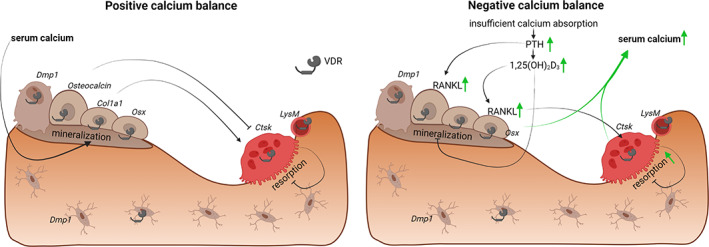Fig 2.

During a positive calcium balance (left panel), normal serum calcium concentrations allow proper bone mineralization. Transgenic models with Vdr inactivation in osteoprogenitors (Osx‐Cre( 51 )) or in mature osteoblasts and osteocytes (Dmp1‐Cre( 26 )) display normal mineral and bone homeostasis. Vdr knockdown in immature osteoblasts (Col1a1‐Cre( 49 )) induces bone mass, whereas Vdr overexpression in mature osteoblasts (Osteocalcin‐Cre( 48 , 50 )) also leads to an elevated bone mass. Vdr inactivation in osteoclast precursors (LysM‐Cre( 57 )) does not affect bone homeostasis, whereas Vdr‐silencing in mature osteoclasts (Ctsk‐Cre) has either no effect( 51 ) or leads to a slight reduction in bone mass.( 58 ) During a negative calcium balance (right panel), insufficient intestinal calcium absorption leads to increased PTH and 1,25(OH)2D3 levels, which stimulate RANKL expression by osteoblasts and enhance bone resorption.( 52 ) Moreover, 1,25(OH)2D3 inhibits bone mineralization by directly inducing the expression of mineralization inhibitors.( 26 ) Elevated resorption and decreased mineralization both contribute to the maintenance of normocalcemia. Mice with selective Vdr knockdown in mature osteoclasts (Ctsk‐Cre( 59 )) experience a greater bone loss during a negative calcium balance. (Figure created with BioRender.com.)
